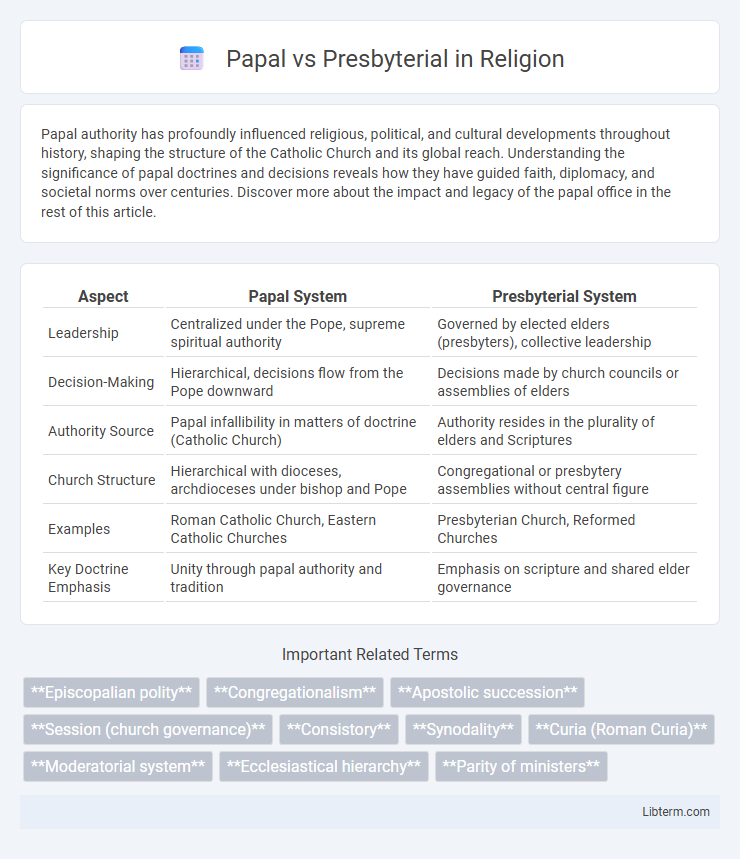Papal authority has profoundly influenced religious, political, and cultural developments throughout history, shaping the structure of the Catholic Church and its global reach. Understanding the significance of papal doctrines and decisions reveals how they have guided faith, diplomacy, and societal norms over centuries. Discover more about the impact and legacy of the papal office in the rest of this article.
Table of Comparison
| Aspect | Papal System | Presbyterial System |
|---|---|---|
| Leadership | Centralized under the Pope, supreme spiritual authority | Governed by elected elders (presbyters), collective leadership |
| Decision-Making | Hierarchical, decisions flow from the Pope downward | Decisions made by church councils or assemblies of elders |
| Authority Source | Papal infallibility in matters of doctrine (Catholic Church) | Authority resides in the plurality of elders and Scriptures |
| Church Structure | Hierarchical with dioceses, archdioceses under bishop and Pope | Congregational or presbytery assemblies without central figure |
| Examples | Roman Catholic Church, Eastern Catholic Churches | Presbyterian Church, Reformed Churches |
| Key Doctrine Emphasis | Unity through papal authority and tradition | Emphasis on scripture and shared elder governance |
Introduction to Church Governance
Papal governance centralizes authority in the Pope, who exercises supreme jurisdiction over the Catholic Church, ensuring doctrinal unity and hierarchical oversight. Presbyterial governance emphasizes a council of elders or presbyters sharing leadership responsibilities, common in Presbyterian and Reformed churches, promoting collective decision-making and accountability. These distinct models reflect varying theological understandings of church authority and organizational structure.
Historical Origins of Papal and Presbyterial Systems
The Papal system originated in the early Christian Church, evolving from the bishop of Rome's authority as the successor of Saint Peter and establishing centralized spiritual and administrative leadership within Roman Catholicism. The Presbyterial system traces back to the New Testament church structure, emphasizing governance by a group of elders or presbyters, which became foundational in Reformed and Presbyterian denominations. Both systems reflect divergent historical development paths in Christian ecclesiology, rooted in differing interpretations of church authority and leadership roles.
Definition of Papal Authority
Papal authority refers to the supreme and universal power exercised by the pope as the spiritual leader of the Roman Catholic Church, encompassing doctrinal, disciplinary, and administrative aspects. This authority is believed to be derived from the apostolic succession of Saint Peter, granting the pope the role of the Vicar of Christ on earth. In contrast, presbyterial systems distribute leadership across a council of elders or presbyters, emphasizing collective decision-making rather than centralized papal control.
Structure of the Presbyterial System
The presbyterial system is characterized by a representative structure where authority is vested in elected elders or presbyters who govern collectively in councils or sessions. Decision-making occurs through a series of graded assemblies, such as sessions, presbyteries, synods, and general assemblies, ensuring a balance of power without a single hierarchical leader. This structure emphasizes democratic participation and accountability within the church governance framework.
Theological Foundations: Papal vs Presbyterial
Theological foundations of the Papal system emphasize the supreme authority of the Pope as the spiritual leader and Vicar of Christ, rooted in the Petrine doctrine and apostolic succession. In contrast, the Presbyterial model is grounded in the collective leadership of elders (presbyters) and stresses the priesthood of all believers, with authority distributed within councils or synods rather than centralized in a single figure. These divergent theological bases highlight fundamentally different understandings of ecclesial authority and church governance in Catholicism versus Presbyterian traditions.
Decision-Making Processes Compared
Papal decision-making centralizes authority in the pope, who holds supreme, often unilateral, power over doctrinal, disciplinary, and administrative matters in the Catholic Church. Presbyterial systems, such as those in Presbyterian or Reformed churches, distribute decision-making among elected elders and councils, emphasizing collective governance and consensus. This comparative structure influences not only church polity but also the speed and nature of doctrinal development and conflict resolution.
Role of Clergy in Both Systems
In the Papal system, clergy serve under the direct authority of the Pope, emphasizing a hierarchical structure with the Pope as the supreme spiritual leader. In contrast, the Presbyterial system features a collective leadership model where elders or presbyters share decision-making authority without a singular central figure like the Pope. Clergy in Presbyterial churches function more collaboratively, often engaging in local governance and pastoral care within their congregations.
Influence on Church Policy and Doctrine
Papal governance centralizes authority in the Pope, allowing for unified doctrine and cohesive church policy across the global Catholic community. Presbyterial systems distribute power among elected elders or presbyters, promoting localized decision-making and adaptability in church practices. This decentralized structure often results in diverse interpretations of doctrine and varied policy implementations within individual congregations.
Modern-Day Examples and Practices
Modern-day papal governance is exemplified by the Roman Catholic Church, where the Pope holds supreme authority over doctrine, liturgy, and church administration worldwide. In contrast, presbyterial systems are observed in Presbyterian denominations such as the Church of Scotland and the Presbyterian Church (USA), where governance is shared among elected elders and assemblies, emphasizing collective decision-making. These differing structures influence contemporary worship, leadership accountability, and ecclesiastical polity, shaping how communities engage with religious authority and church life.
Conclusion: Comparing Strengths and Challenges
Papal systems centralize authority in the Pope, providing clear doctrinal unity and hierarchical governance, which strengthens organizational coherence but may face challenges in addressing local diversity. Presbyterial systems emphasize collective leadership through elders, fostering adaptability and local representation, yet they can encounter difficulties in maintaining uniformity and centralized decision-making. Balancing these strengths and challenges depends on prioritizing either centralized authority or broader participatory governance within church structures.
Papal Infographic

 libterm.com
libterm.com